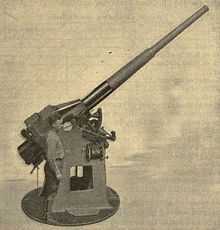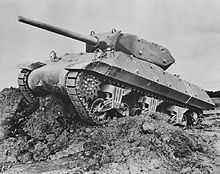3-inch Gun M1918
| 3 Inch / 50 Cal Gun (Mk 22) | |
|---|---|
 3-inch M1918 on towed trailer mount | |
| Type | Anti-Aircraft Gun |
| Place of origin | United States |
| Service history | |
| Used by | United States Armed Forces |
The 3-inch M1918 gun was a United States 3-inch anti-aircraft gun that entered service in 1918 and served until it was finally superseded by the 3" M3 gun in 1930. The M3 was subsequently replaced by the M1 90mm AA gun just prior to the opening of World War II. The M3 3" gun was later adapted for the anti-tank role, serving as the main armament of the M10 tank destroyer during World War II.
The predecessor : 3-inch M1917

The 3-inch M1917 was the US Army's first dedicated anti-aircraft gun, entering service during World War I. Only a few were built, as the similar 3-inch M1918 on a mobile mount was considered more useful and was produced in large numbers.
Development of the M1917 started in 1915, and as the name implies, took two years to enter service. The gun was essentially an unmodified 3-inch M1903 (76.2 mm L/55) coastal-defense gun on a new mount allowing it to be aimed to high elevations. A number were used during the war. In the immediate post-war era it was developed as the 3-inch M1, using a removable barrel liner. In 1928 it was further improved in the 3-inch M3 by using a thicker removable liner that eased manufacturing.
History of the 3-inch M1918


|
| |
|
| |
|
| |
|
| |
|
| |
|
| |
|
|
For mobile use the original coastal gun was too heavy, so a smaller version was developed as the 3-inch M1918. For this role the barrel was cut down in length, to 50 calibers from 55, and a new breech was introduced to fire smaller rounds (76.2x585R, 212 cubic inches instead of 76.2x690R, 293 cubic inches). Like the adaptation that created the M2, the M1918 was also fitted with a removable liner in 1928, becoming the 3-inch M3. Another upgrade was started in 1931 as the T8, and then T9, but these projects were cancelled in 1938 when the 90 mm gun was selected in their place.
In September 1940 a project started to adapt the 3-inch gun to the anti-tank role, starting with the T9 experimental model but equipping it with the breech, recoil system and carriage borrowed from the 105mm M2 howitzer. The gun was accepted for service as the 3-inch M5.
A similar derivative of the T9 - the 3-inch M6 - was intended to be mounted on the M5 self-propelled gun, which was eventually abandoned. A final adaptation was the 3-inch M7, which included minor modifications for mounting on the M10 Wolverine. M7 saw wide use although it was supplanted to some extent by more powerful weapons such as the 90mm M3 and the British QF 17 pounder. 6,824 M7 guns were manufactured.[1]
Variants
- 3-inch Gun M1917 - Original fixed-place anti-aircraft gun introduced in 1917.
- M1918 - Mobile anti-aircraft gun using a cut-down version of the original M1917 gun and a new mount.
- M1 - Variant of the M1918 with a removable barrel liner.
- M2 - Variant of the M1917 with a removable barrel liner.
- M3 - Development of the M1917 with a removable barrel liner, but a mobile system like the M1918.
- M4 - Version of the M2 with a thicker liner for easier manufacturing.
- M5 - Version of the T9 adapted for anti-tank use.
- M6 - Version of the T9 as mounted in the 3in Gun Motor Carriage M5.
- M7 - Version of the M5 for use on the 3in Gun Motor Carriage M10.
Self-propelled mounts
- Heavy Tank M6 (M7 gun in mount T49).[2]
- 3in Antiaircraft Gun Carriage T1 (Garford 7½ ton 6x4 truck chassis).[3]
- 3in Gun Motor Carriage T1 / M5 (high speed tractor M2 chassis, M6 gun).[4]
- 3in Gun Motor Carriage T7 (Trackless Tank chassis).[5]
- 3in Gun Motor Carriage T15 (Ford 4x4 / 6x6 truck chassis).[6]
- 3in Gun Motor Carriage T20 (Light Tank M3 chassis).[7]
- 3in Gun Motor Carriage T24 (Medium Tank M3 chassis, M3 gun).[8]
- 3in Gun Motor Carriage T35 / M10 (M4 Sherman chassis, M7 gun in mount M5).[9]
- 3in Gun Motor Carriage T40 / M9 (Medium Tank M3 chassis, M1918 gun).[8]
- 3in Gun Motor Carriage T50.[7]
- 3in Gun Motor Carriage T55.[6]
- 3in Gun Motor Carriage T56, T57 (Light Tank M3A3 chassis, M7 gun).[7]
Surviving examples
The only known surviving example is located at the Fort Sill museum.
See also
Weapons of comparable role, performance and era
- QF 3 inch 20 cwt : British equivalent anti-aircraft gun
- Type 88 75 mm AA Gun : Japanese equivalent anti-aircraft gun
Notes
- ↑ Chamberlain, Gander - Anti-Tank Weapons, p 49.
- ↑ Hunnicutt, R. P. - Firepower: A History of the American Heavy Tank, p 193, 194, 213.
- ↑ Hunnicutt, R. P. - Armored Car: A History of American Wheeled Combat Vehicles., p 41.
- ↑ Hunnicutt, R. P. - Stuart: A History of the American Light Tank, p 295-296.
- ↑ Hunnicutt, R. P. - Armored Car: A History of American Wheeled Combat Vehicles., p 71, 164.
- ↑ 6.0 6.1 Hunnicutt, R. P. - Armored Car: A History of American Wheeled Combat Vehicles., p 163, 164.
- ↑ 7.0 7.1 7.2 Hunnicutt, R. P. - Stuart: A History of the American Light Tank, p 298-301.
- ↑ 8.0 8.1 Hunnicutt, R. P. - Sherman: A History of the American Medium Tank, p 360-361.
- ↑ Hunnicutt, R. P. - Sherman: A History of the American Medium Tank, p 557.
References
- Chamberlain, Peter and Gander, Terry - Anti-Tank Weapons, Arco Publishing Company, New York, 1974 (WWII Fact Files), ISBN 0-668-03505-6.
- Hunnicutt, R. P. - Armored Car: A History of American Wheeled Combat Vehicles., Presidio Press 2002, ISBN 0-89141-777-X.
- Hunnicutt, R. P. - Stuart: A History of the American Light Tank, Presidio Press 1992, ISBN 0-89141-462-2.
- Hunnicutt, R. P. - Sherman: A History of the American Medium Tank., Presidio Press 1994, ISBN 0-89141-080-5.
- Hunnicutt, R. P. - Firepower: A History of the American Heavy Tank., Presidio Press 1988, ISBN 0-89141-304-9.
- TM 9-421
External links
| Wikimedia Commons has media related to 3 inch M1918 AA gun. |
- "Fast Motorized Guns With Steel Brains - Built To Hunt Planes In Next War" Popular Mechanics, March 1930, pp 458-459
- United States. Army. Ordnance Dept, "Handbook of artillery : including mobile, anti-aircraft and trench matériel", May 1920. See "3-Inch Anti-Aircraft Gun, Model 1918" Pages 326–339
- Training Air Defense August 1940 Popular Mechanicsarticle on 3-inch M3 coastal defense unit
- M5 & M7 armor penetration table
- http://www.archive.org/details/americasmunitio01deptgoog World War I material statistics, and pics.
- https://www.bliss.army.mil/Museum/fort_bliss_museum.htm only survivor located here.
| ||||||||||||||||||||
| ||||||||||||||||||||||||||